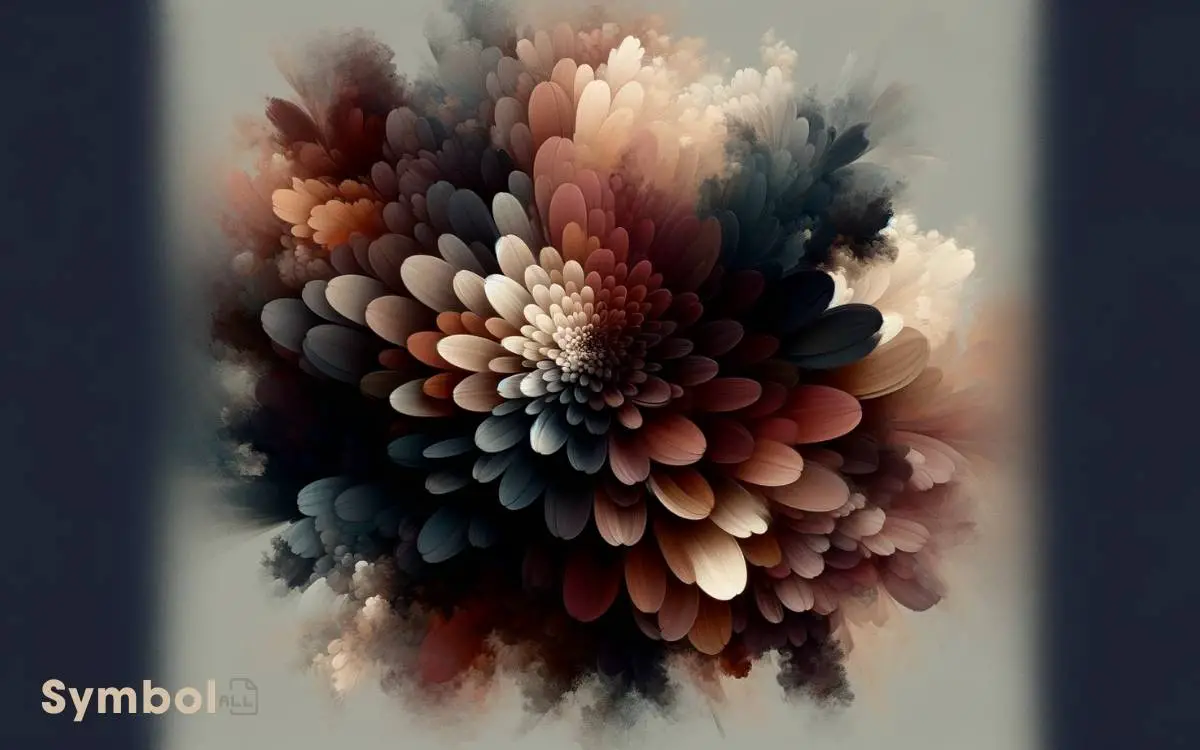What Color Chrysanthemum Symbolism Death? White!
In many cultures, white chrysanthemums are deeply linked to mourning and death. They express purity, grief, and the complexity of loss through their myriad petals.
These flowers are often chosen for funerals and memorial sites, conveying condolences and remembrance without words. While white symbolizes mourning in Eastern traditions, darker hues like purple or black may carry similar meanings in Western contexts.
You’ll find that the language of flowers, including the subtly different messages conveyed by chrysanthemum colors, offers a rich tapestry of cultural and personal significance.
Exploring further, you’ll uncover how these symbols vary and intertwine globally, enriching your understanding.

Key Takeaways
The Significance of Chrysanthemums
Chrysanthemums often explore deep cultural and symbolic meanings, especially when it comes to commemorating the deceased. You’ll find these flowers across various cultures, each attributing its unique significance to them.
In many parts of the world, chrysanthemums are chosen for funerals and grave sites, symbolizing honor, respect, and a deep sense of loss. They’re not just flowers; they’re a way to express sentiments that words alone can’t convey.
Their diverse colors, each with its own meaning, allow for personalized expressions of grief and remembrance. While we won’t investigate into specific colors here, it’s important to understand that the choice of a chrysanthemum at a memorial service isn’t arbitrary.
It’s a thoughtful selection, deeply rooted in tradition and personal significance, offering solace and expressing condolences in a profound way.
White Chrysanthemums and Mourning
In the domain of mourning, white chrysanthemums hold a special place, symbolizing purity and grief with a grace that words often fail to capture. You’ll find that these flowers aren’t merely decorative; they carry a profound meaning, especially during times of loss.
| Feature | Significance | Context |
|---|---|---|
| Color | Purity | Often associated with innocence and spiritual purity in times of mourning. |
| Petals | Grief | The numerous petals represent the various aspects of grief, encompassing a range of emotions. |
| Bloom | Life Cycle | Symbolizes the cycle of life, from birth to death, reminding us of the impermanence of life. |
| Use | Mourning | Commonly used in funerals and memorials to express condolences and honor the deceased. |
Understanding the symbolism of white chrysanthemums can help you appreciate their role in conveying condolences and expressing sorrow.
Cultural Interpretations of Color
Color symbolism varies greatly across cultures, often reflecting deep-seated beliefs and traditions that influence perceptions of mourning and remembrance.
In many Eastern societies, white chrysanthemums are a symbol of grief and lamentation, embodying purity and the sorrow of loss. They’re commonly used in funerals and memorial services, offering a way to express condolences without words.
Conversely, in some Western contexts, dark colors like deep purple or black may signify mourning, but chrysanthemums in these hues are less common.
Instead, you’ll find white and yellow chrysanthemums, with yellow often representing slighted love or sorrow in this cultural framework.
Understanding these nuances helps you navigate the complex language of flowers, ensuring your floral tribute carries the intended message across diverse cultural landscapes.
Historical Contexts of Floral Symbolism
You’ll find that throughout history, civilizations have used floral codes to express sentiments of mourning and remembrance.
The evolution of mourning flowers showcases how different cultures have embraced or altered these symbols over time.
Understanding cultural differences in symbolism offers a rich insight into how the chrysanthemum’s meaning has transformed across various contexts.
Ancient Civilizations Floral Codes
Throughout history, ancient civilizations have used floral codes to convey messages of life, death, and rebirth, with each flower, including the chrysanthemum, holding its own unique symbolism.
- Egyptians: They often adorned tombs with flowers, believing they symbolized the afterlife’s resurrection. The lotus, in particular, signified rebirth.
- Greeks and Romans: These civilizations used flowers in funeral rites and memorials, with specific blooms like the poppy symbolizing eternal sleep and peace.
- Chinese Culture: Here, the chrysanthemum has a significant role, representing longevity and immortality. During particular festivals, it’s a reminder of life’s cyclical nature.
Your understanding of the chrysanthemum’s color in this context enriches your appreciation of its historical significance, illustrating how deeply intertwined floral symbolism is with human expressions of mourning and memory. In many cultures, the chrysanthemum’s hues serve as powerful metaphors for the cycles of life, death, and remembrance, with each shade carrying its own distinct message. For instance, the meaning of the color magenta in chrysanthemums often evokes a sense of profound emotional bonding, symbolizing love and passion that transcend the physical realm. This layered symbolism underscores the profound role flowers play in bridging the ephemeral and the eternal, offering solace and connection even in times of sorrow.
Evolution of Mourning Flowers
As we explore the evolution of mourning flowers, it’s evident that the symbolism attached to these blooms has transformed greatly over centuries, reflecting changes in cultural attitudes towards death and remembrance.
Initially, flowers served a practical purpose in masking odors during funerals. Over time, their role shifted to embodying messages of love, sorrow, and respect for the departed.
This shift was influenced by evolving religious and societal norms which emphasized commemorating the dead with dignity and reverence.
Each era brought its own preferred flowers and arrangements, mirroring contemporary beliefs about the afterlife and the nature of mourning.
Today, the choice of mourning flowers is deeply personal, yet still steeped in tradition, conveying heartfelt messages that words alone can’t express.
Cultural Differences in Symbolism
Delving into the historical contexts of floral symbolism reveals profound cultural differences in how societies perceive and utilize flowers in mourning rituals. While you might associate white chrysanthemums with purity and reverence, this symbolism isn’t universal.
- In Japan, white chrysanthemums are a traditional symbol of grief and lamentation, often used exclusively in funerals and grave decorations.
- In Europe, especially in Mediterranean countries, chrysanthemums of various colors are common in remembrance, symbolizing death but also the beauty of life.
- In the United States, the color and type of flower, including chrysanthemums, can vary widely depending on personal preference, regional traditions, and the deceased’s personality, showing a more individualized approach to mourning.
These variations highlight the rich tapestry of meanings and practices surrounding death and the use of chrysanthemums in mourning across cultures.
Modern Funeral Practices
As you explore modern funeral practices, you’ll notice the rich tapestry of cultural funeral variations that exist worldwide, each with its unique customs and symbolic uses of chrysanthemums.
Additionally, there’s a growing trend towards eco-friendly burial options, reflecting a societal shift towards sustainability even in death.
These practices not only honor the deceased but also pay homage to the environment, showcasing a profound respect for the cycle of life.
Cultural Funeral Variations
Modern funeral practices vary widely across cultures, reflecting unique traditions and beliefs about death and remembrance. As you explore these customs, you’ll discover the rich diversity in how societies honor their deceased.
- Japan: Funerals often involve Buddhist ceremonies, including a wake, cremation, and a memorial service, where chrysanthemums are a common floral tribute, symbolizing lamentation and grief.
- Ghana: Elaborate fantasy coffins designed to represent the deceased’s profession or passions are a notable tradition, illustrating a unique celebration of life.
- Mexico: The Day of the Dead (Día de los Muertos) merges Indigenous and Catholic practices, where families create altars with offerings to welcome the spirits of the deceased back to the world of the living for a brief reunion.
These variations underscore the global tapestry of funeral practices, each with its own way of expressing respect, mourning, and the celebration of life.
Eco-Friendly Burial Options
Increasingly, individuals are considering eco-friendly burial options as a way to guarantee their final act is kind to the planet.
You may be contemplating a green burial, which avoids the use of embalming chemicals and metal caskets, instead favoring biodegradable materials. This approach guarantees that your departure doesn’t harm the environment, allowing your body to return naturally to the earth.
Another option is a tree burial, where your ashes nourish a newly planted tree, symbolizing life’s continuation. You’re not only choosing a sustainable goodbye but also contributing to reforestation efforts.
Variations Across Countries
The cultural significance of chrysanthemum colors in mourning practices varies greatly from one country to another. This flower, often associated with death and mourning, carries different meanings around the globe.
Understanding these variations can deepen your appreciation for chrysanthemum’s role in memorial traditions.
- Japan: White chrysanthemums are exclusively used in funeral arrangements and at gravesites, symbolizing grief and lamentation.
- China: White is also the color of mourning here, but chrysanthemums are more broadly symbolizing lamentation and adversity.
- France: While not exclusively linked to mourning, chrysanthemums are traditionally placed on graves on All Saints’ Day as a gesture of remembrance and respect.
These examples underscore the importance of cultural context when interpreting the symbolism of chrysanthemums in mourning practices.
Personal and Collective Grief
Chrysanthemums bridge the gap between personal and collective grief, offering a symbol through which individuals and communities can express their sorrow and remembrance.
When you choose a chrysanthemum to honor someone who’s passed, you’re participating in a tradition that stretches across cultures and history.
These flowers carry the weight of your loss, but also the beauty of the life remembered. They serve as a tangible connection to the departed, allowing for a shared expression of mourning.
In moments of silence, the presence of chrysanthemums speaks volumes, offering solace in their color and form.
They’re not just flowers; they’re vessels of memory, carrying personal tales of love and loss into a collective space of healing and honor.
Choosing Flowers for Memorials
Selecting the right flowers for memorials allows you to pay a heartfelt tribute, reflecting the unique spirit and preferences of the loved ones you’re honoring.
When making your choice, consider the following:
- Symbolism: Different flowers carry different meanings. For example, white chrysanthemums are often associated with mourning and respect in many cultures, making them a fitting choice for memorials.
- Personal Preferences: Did the deceased have a favorite flower or color? Incorporating these into the arrangements can add a personal touch that celebrates their individuality.
- Cultural Traditions: Be mindful of cultural norms and traditions regarding flowers and colors. What’s considered respectful in one culture mightn’t be in another.
Choosing thoughtfully can create a deeply meaningful and respectful homage to those who’ve passed.
Beyond Death: Hope and Rebirth
While chrysanthemums might symbolize mourning, they also embody the promise of hope and rebirth, offering solace during times of grief.
In many cultures, these flowers are not just tokens of the end but are beacons for the journey onward, symbolizing the cycle of life, death, and rebirth. They remind you that after every ending comes a new beginning, a fresh start that is as inevitable as the seasons’ change.
| Color | Meaning | Context |
|---|---|---|
| White | Purity, Hope | Often used in funerals to signify rebirth |
| Yellow | Sorrow, Neglected Love | Yet, in some cultures, represents new life |
| Pink | Renewal, Optimism | A gentle reminder of joy after sorrow |
These colors weave a tapestry of emotions, guiding you through mourning towards hope and renewal.
Conclusion
As you’ve journeyed through the layers of chrysanthemum symbolism, from the stark whites of mourning to the cultural tapestries that color our perception of death, you stand at a crossroad. Choosing the right flower for a memorial speaks volumes, weaving hope into the fabric of grief.
Remember, in every petal lies a story, a bridge between the past and a future rebirth. So, what’ll your choice whisper to the world? The answer holds a poignant beauty, awaiting your discovery.






